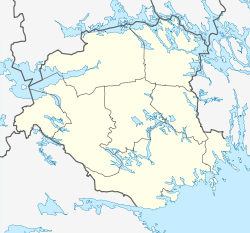Mariefred
| Mariefred | |
|---|---|
|
Mariefred in August 2005, view from Gripsholm Castle | |
 Mariefred  Mariefred | |
| Coordinates: 59°16′N 17°13′E / 59.267°N 17.217°ECoordinates: 59°16′N 17°13′E / 59.267°N 17.217°E | |
| Country | Sweden |
| Province | Södermanland |
| County | Södermanland County |
| Municipality | Strängnäs Municipality |
| Area[1] | |
| • Total | 2.51 km2 (0.97 sq mi) |
| Population (31 December 2010)[1] | |
| • Total | 3,726 |
| • Density | 1,487/km2 (3,850/sq mi) |
| Time zone | CET (UTC+1) |
| • Summer (DST) | CEST (UTC+2) |
Mariefred is a locality situated in Strängnäs Municipality, Södermanland County, Sweden with 3,726 inhabitants in 2010.[1]
The name is derived from that of the former Carthusian monastery here, Mariefred Charterhouse, and means "Peace of Mary" (the former name was Gripsholm). It lies roughly 50 kilometres west of Stockholm.
Mariefred, despite its small population, is for historical reasons often still referred to as a city. Statistics Sweden, however, only counts localities with more than 10,000 inhabitants as cities.
The Royal Gripsholm Castle is located in the town.
The old barn of Gripsholm Castle is now a centre for fine arts printmaking, Grafikens Hus ("House of Graphics").
The East Södermanland Railway has a railway museum here with one of the finest collections of 600 mm narrow-gauge passenger railcars anywhere.
Kurt Tucholsky is buried in the town cemetery.
Notable natives
Pop and jazz singer Lisa Ekdahl was raised in Mariefred.
Famous Swedish actor Dolph Lundgren has a summer home in Mariefred, Kalkudden.
Mikael Samuelsson, a former professional ice hockey player of the National Hockey League (NHL), was born in Mariefred. Samuelsson is a member of the exclusive Triple Gold Club, having won the Stanley Cup, Olympics, and World Championship.
Other notable residents
The Pirate Bay Founder, Gottfrid Svartholm Warg is currently a prisoner of the Mariefred Prison, sentenced for facilitating the Distribution of Copyrighted Media.
References
| Wikimedia Commons has media related to Mariefred. |
- 1 2 3 "Tätorternas landareal, folkmängd och invånare per km2 2005 och 2010" (in Swedish). Statistics Sweden. 14 December 2011. Archived from the original on 10 January 2012. Retrieved 10 January 2012.
